AACtual Therapy with Shareka Bentham: Navigating Eye Gaze for Beginning Communicators
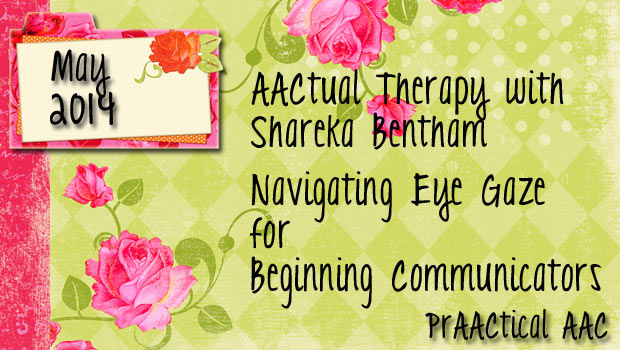
Today, we welcome back Shareka Bentham, who has told us about her AAC adventures with the Harlem Shake, a field trip, and more. In this post, she shares her experiences in getting little ones started on the intentional use of eye gaze for communication.
:::::::::::::::::::::::::::::::::::::::::::::::::::::::::
I think that most Speech & Language Therapists have those moments in therapy where they’re wondering “Am I doing the right thing here??” I have been feeling that way recently in my practice as I have been nudged into the world of using the head and eyes for communication. I was (with extensive research) once able to use an eye gaze board quite successfully with an adult patient in the final stages of ALS, but I had never used such techniques in my paediatric clinic. However, I now have a few little ones on my caseload who have severe physical limitations, and are unable to use their limbs for switch access without considerable effort and physical manipulation, which really defeats the whole purpose of communication. I believe as a therapist that communication should have minimal effort and that means of communication should be readily accessed for ease of interaction; therefore I have moved to body parts which can be moved more easily, which are the head and eyes.
In my AAC research and therapy observations, I have seen eye gaze used in older clients with higher levels of functioning, to quickly make choices or build sentences to engage in conversation. However my experience and readings have been quite limited in relation to using this type of communication for what I would consider the lower functioning emerging communicators. My dilemma was
“How do I begin to show these little ones that they can use their eyes to get a response from others, or to get what they want?”
I started to modify my therapy to draw from what I learnt about child language development and interaction, particularly from my training in the Hanen ‘It takes Two to Talk’ programme, and linked those to what I wanted to achieve in the AAC goals. I kept thinking about what I would have usually chosen for my children to do with their hands, and then replaced hands with head/eyes.
My first goal was to use play activities (song, people, and toy play) to show the children that they could use their head and/or eyes to get more of an object or interaction. Activities included:
- Looking over to mum in order to request more tickles/jiggles
- Looking to a symbol/object to request more of a song
- Looking to a side to find the puppet that’s hiding
- Looking to request more food
I found that all of the children needed initial practice in tracking, to be able follow the desired objects from side to side. I used activities such as the “follow the snake” game below to help with this.
Another goal at a higher level was using eye gaze and/or head turn to discriminate between two objects/symbols. Puppet play was usually the most fun activity to help elicit a response, but activities were generally tailored to the child’s interests.
For some little ones I have been able to move on to using head turn and eye gaze to respond to “Find the…” or “Where’s the…” instructions. A favourite of mine for this goal has been to find the animals to put on the farm.
Progression with these goals has come with its share of obstacles as well. Getting a consistent head/eye response was quite difficult, initially, particularly with children with low tone who required more head support, or who favoured the stronger side as a result of hemiplegia. There was also the case where the head would come over but the eyes would still be looking in the opposite direction. Furthermore, for each child there was always the difficulty that during each activity there might be some sudden distraction in the room that the child would reflexively orient towards (or away from), and it was sometimes hard to regain that consistent gaze away from the distraction and back to the activity.
Progress has been positive thus far across activities and goals. However, this is still a work in progress, and I would welcome any feedback as I continue to navigate through this new area of AAC.
Filed under: PrAACtical Thinking
Tagged With: beginning communicator, eye gaze, Shareka Bentham
This post was written by Carole Zangari



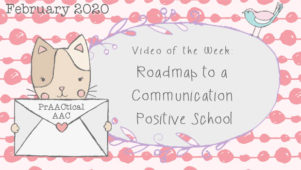
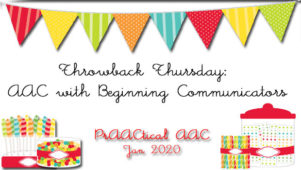
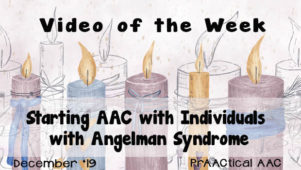
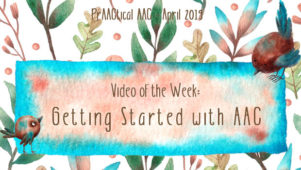
6 Comments
I recently began to work with a preschooler that has an eye gaze -AAC device with voice output. Head control is an issue and although he is not always accurate, he is really trying! We are working on core vocabulary words that I got from Practical AAC.
Thanks again, Carole. I continue to gain wonderful insights from your postings and sharings. It has helped me so much and given me so much good encouragement to advocate for the most complex-needy students. Everyone communicates!
So glad to hear this, Geri! It can be a long road for the little ones with complex communication needs to get good at eye gaze, but we have to start somewhere, right? Thanks for taking the time to stop by and comment. 🙂
I have found that I need to work very closely with my physical therapists. For some children, providing more neck and head support during the initial training and practicing, allows the student to focus on using their eyes. They don’t have to put any energy into activating their trunk and back and neck for head control, and can use their resources for attending and tracking.
When teaching choice making via eye gaze, I always tell the child and ALL caregivers to verbally tell what the choices are, have the child look back at the adult, then say “which one….?” And take the first thing they look at. Don’t let them go back an forth, don’t make them look for “5 sec,” and don’t send guess them with “are you sure that’s the one you want?” I have found that theses strategies help the child learn the power of their gaze.
Thanks so much for your feedback. I’m looking into collaborating with his physiotherapist in the new year to help meet our goals. I find that we’re getting the eye gaze, but it is still quite fleeting…less than 5 seconds, so not enough time to really lock in.
Most eye gaze devices use a dwell time of less than 1 second. When I learned this, I stop requiring such long hold time. My client that is 12 using eye gaze has a swell time of .7 seconds which is average. Carol, any thoughts on this topic?